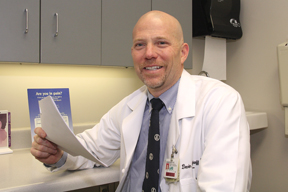 |
| Organ donation at UAB has increased more than 80 percent since 2004, says Devin E. Eckhoff, director of the Division of Transplantation. Changes in policy, approach, technology and personnel have lead to an increase in donations. |
More than 98,000 Americans were awaiting an organ transplant in mid February according to the Web site organdonor.gov, and a new person is added to the list every 18 minutes. At UAB, changes in policy, approach, technology and personnel have led to an increase in donations – and more lives are being saved.
Organ donation at UAB has increased more than 80 percent since 2004, and the future is promising additional gains, says Devin E. Eckhoff, M.D., director of the Division of Transplantation and medical director of the Alabama Organ Center, a federally designated organ-procurement organization (OPO).
Eckhoff says the improvements, which also are happening in other parts of the country, are due to several new strategies that were developed after encouragement from former U.S. Health and Human Services Secretary Tommy Thompson. Prior to 2004 public education efforts around the nation failed to increase the number of deceased donors, which number about 100 annually in Alabama. UAB’s organ-transplant volume remained among the nation’s highest, primarily because of a significant increase in kidney donations by living donors, but the OPO community as a whole needed a spark.
“The whole OPO community and organ-donation efforts had stagnated. The standard education efforts were failing to increase organ donation,” Eckhoff says.
“Then Secretary Thompson asked the organ-donation community to take a new look at everything and question the age-old assumptions about how to do it.”
Implementing change
The Alabama Organ Center (AOC) tackled the issue on three fronts: First, it implemented the clinical-triggers card for making a referral to the AOC; second, it implemented a Family Support Services Coordinators program; third, the AOC has increased the visibility of its Donation after Cardiac Death (DCD) program.
The clinical triggers enable a timely referral allowing the AOC’s specially trained staff to go to the hospital to perform an evaluation of donor suitability and to provide family and staff support. “Patients who are potential donors usually are previously healthy people who have experienced a sudden or traumatic death,” Eckhoff says. “Consequently, their families have some unique education and bereavement needs.”
The Family Support Services Coordinators are particularly skilled in bereavement support and family care. The AOC has three full-time coordinators in Birmingham and Mobile and one shared coordinator at UAB Hospital, Wendy Walters. The coordinators counsel the families and stay with them as long as needed, regardless of the family’s donation decision.
“Since the implementation of this program we have seen an increase in our consent rates and improved satisfaction from our families and hospitals,” Eckhoff says.
DCD program
DCD is an option for patients who are neurologically devastated, but not brain dead. The Joint Commission recommended that all hospitals that have ventilator capability have a policy to address DCD to be implemented in January 2007.
The families of these patients, in conjunction with the attending physician, have chosen to withdraw support and also wish to donate organs for transplant.
“If the patient is medically suitable for donation, the AOC will work with the primary care team to coordinate the recovery of organs for transplant after cardiac death has been determined by the attending physician,” Eckhoff says.
The AOC has seen a significant increase in the number of DCD donors the past two years.
From October 2005 to September 2006 there were four DCD donors compared to 11 from October 2006 through September 2007. In October 2007 alone there were two DCD donors.
“While these DCD numbers seem small, they are huge to the patients fortunate enough to be successfully transplanted because of the generosity of a stranger,” Eckhoff says.
New technologies
Eckhoff says adding two new technologies at UAB Hospital will help the AOC pursue all donor candidates.
Nucleic acid amplification testing of donor organ tissue can detect viruses sooner after infection than conventional testing – within 12 days for HIV and 25 days for hepatitis C virus.
“Thus, someone excluded from organ donation because of CDC-defined high-risk behavior, such as homemade tattooing or spending a night in jail, could become a donor after nucleic acid testing,” Eckhoff says. “This test assures potential recipients of our dedication to providing quality, disease-free organs.”
Extracorporeal membrane oxygenation (ECMO) is available for DCD cases. Without ECMO, organ removal must begin within five minutes after patients arrest and are pronounced dead. ECMO avoids the need to rush organ removal, and also may improve function of donated organs after transplantation.
The AOC attributes its recent achievements to the effective implementation of these efforts and successful partnerships with physicians, hospitals and nurses across the state.
“It takes all of us working together to provide excellent care to the bereaved family and to save the lives of those waiting for an organ transplant in our state,” Eckhoff says.